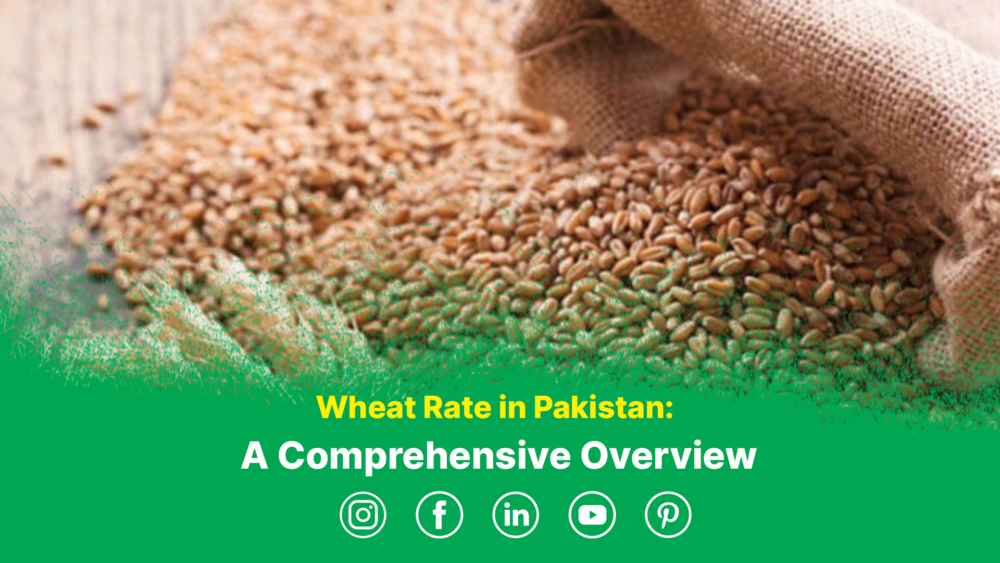Wheat is one of the most significant crops in Pakistan, serving as a staple food for millions and a backbone of the country’s agricultural economy. The price of wheat directly impacts food security, inflation, and economic stability. For this reason, understanding the wheat rate in Pakistan is essential for both consumers and policymakers.
Current Wheat Rate in Pakistan
As of today, the wheat rate in Pakistan fluctuates based on various factors such as regional supply and demand, international trade policies, and market conditions. Farmers, wholesalers, and consumers keep a close eye on the today wheat rate in Pakistan as it affects their livelihood, profit margins, and overall cost of living.
The current wheat rate in Pakistan 2024 stands between PKR 2,800 and PKR 3,500 per 40 kilograms, depending on the province and market conditions. The prices tend to vary slightly across different regions, with urban areas generally experiencing higher prices compared to rural regions.
Factors Influencing the Wheat Rate in Pakistan
Several factors contribute to the rise and fall of wheat prices in Pakistan. Understanding these drivers is crucial for anyone interested in the agriculture sector or monitoring market trends.
1. Supply and Demand
One of the primary factors affecting the wheat rate in Pakistan is the basic principle of supply and demand. During the harvest season, wheat prices are generally lower due to abundant supply. However, as stocks deplete throughout the year, the prices rise due to scarcity.
2. Government Policies
The government plays a significant role in stabilizing the wheat rate in Pakistan. Policies such as price floors, import/export tariffs, and subsidies for farmers directly impact the cost of wheat. The government often sets a minimum support price to ensure farmers receive a fair return on their produce, which can affect market prices.
3. International Wheat Market
Pakistan is not an isolated economy, and global wheat prices influence domestic wheat rates. Fluctuations in the international market, driven by factors like geopolitical tensions, natural disasters in wheat-producing countries, and global demand, also impact the today wheat rate in Pakistan.
4. Weather Conditions
Agriculture is heavily dependent on weather conditions. Droughts, floods, or unseasonal rain can damage crops, resulting in lower yields. When the wheat yield is low due to adverse weather, the wheat rate in Pakistan tends to rise as the supply decreases.
5. Transportation and Distribution Costs
The cost of transporting wheat from rural farming areas to urban centers contributes to the wheat rate in Pakistan. Fuel prices, road infrastructure, and distribution logistics all play a role in determining how much consumers pay for wheat.
Provincial Variations in Wheat Prices
While there is a national average, wheat prices can vary significantly across provinces. For instance, wheat rates in Sindh and Punjab, Pakistan’s primary wheat-producing regions, are often lower compared to regions like Khyber Pakhtunkhwa and Balochistan. This difference is largely due to transportation costs and regional market demands.
Wheat Rate in Punjab
Punjab is the largest wheat-producing province in Pakistan, contributing to over 75% of the country’s total wheat output. Due to its agricultural infrastructure and proximity to markets, the wheat rate in Punjab tends to be more stable compared to other regions.
Wheat Rate in Sindh
Sindh is the second-largest wheat-producing province. The today wheat rate in Sindh is often similar to Punjab, though it can fluctuate based on crop output and regional market conditions.
Wheat Rate in Khyber Pakhtunkhwa and Balochistan
These provinces rely more heavily on wheat imports from Punjab and Sindh, which often results in higher wheat prices. The transportation costs and lower local production drive up the wheat rate in Khyber Pakhtunkhwa and Balochistan.
Impact of Wheat Price on the Economy
The wheat rate in Pakistan has a direct correlation with the country’s inflation and economic stability. When wheat prices rise, the cost of flour and other essential goods follow suit. This can lead to inflationary pressures, reducing the purchasing power of households, particularly in low-income groups.
Furthermore, wheat price hikes can lead to social unrest, as food becomes less affordable for many Pakistanis. This makes managing wheat prices a critical task for the government to ensure political and economic stability.
Government Interventions and Price Stabilization Measures
To stabilize the today wheat rate in Pakistan, the government frequently intervenes in the market. Some of the most common measures include:
1. Wheat Procurement Programs
The government purchases wheat from farmers at predetermined rates to ensure a stable income for agricultural workers. This also allows the state to control the supply of wheat in the market, which helps maintain a balance in prices.
2. Price Control Measures
To prevent hoarding and price manipulation, the government often introduces price control measures during times of scarcity. Law enforcement agencies monitor the market to ensure that wholesalers and retailers adhere to the set price limits.
3. Wheat Imports
In years where domestic wheat production is low, the government resorts to importing wheat from countries like Russia, Ukraine, and the United States. This helps stabilize the wheat rate in Pakistan by increasing the overall supply.
4. Subsidies for Farmers
Subsidies on seeds, fertilizers, and irrigation are provided to encourage farmers to grow more wheat, which, in turn, helps maintain a stable supply and prevent sharp increases in the wheat rate in Pakistan.
Predictions for Future Wheat Prices
Considering current trends, the wheat rate in Pakistan is expected to remain volatile in the coming years. Climate change, fluctuating fuel prices, and global trade conditions will continue to play significant roles in determining wheat prices. As a result, both the government and private sector must remain vigilant and adapt to these changing conditions to ensure food security.
The wheat rate in Pakistan is influenced by a myriad of factors, from local supply and demand to international market conditions and government policies. Staying informed about these trends is crucial for both consumers and businesses involved in agriculture. While prices are likely to remain unstable, government interventions and sound agricultural practices can help stabilize the market in the long run.
